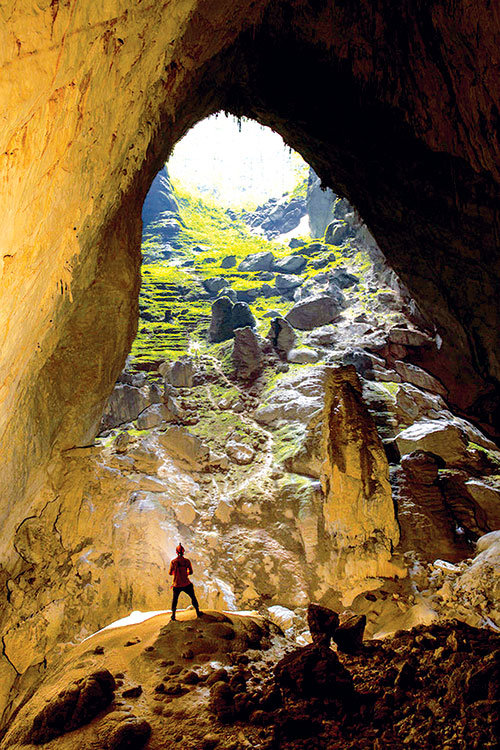After raising the question of whether it is necessary to install a cable car system in Son Doong Cave – the world’s current largest – in UNESCO-recognized Phong Nha-Ke Bang National Park, Tuoi Tre (Youth) newspaper has received thoughts from conservation and tourism experts as well as local state officials with both positive and negative opinions.
On October 22, the north-central province of Quang Binh announced it had permitted Sun Group – a local developer of tourism properties – to conduct surveys for the construction of a cable car system that would take tourists to Son Doong.
The proposed 10.6km long system, which would cost roughly US$141-211.5 million, will have four sections and begin at the entrance to Tien Son Grotto.
The total travel time from the first to the last stations would be about 80 minutes. If built, it would be longest cable car in the world.
Those opposed to the installation of the cable car system said they worry that construction will destroy the unique landscape and environment of the cave.
Truong Hoang Phuong, director of Exotic Vietnam Co., told Tuoi Tre that those who came up with this plan only looked at the economic benefit, without paying attention to the nature and characteristics of tourism, including ecotourism and adventure tourism.
“Building the system to bring a large number of visitors to the area will have to be accompanied by infrastructure to support more people, such as the construction of new roads, hotels and restaurants, and preparing human resources to run these kinds of services,” he said.
“With all of that development, people will intervene directly in the environment which characterizes Son Doong and has helped it become famous. As a result, Son Doong will never be the old Son Doong again,” Phuong added.
Nguyen Chau A, director of the tourism agency Oxalis – currently the sole agency bringing tourists to the cave – said visitors to Son Doong “are very unique, as it will take those wishing to visit the area a day and a half of walking with a three-person support team including porters, cooks, guides and experts.”
“The price for the five-day four-night program is about $3,000, but it has a waiting list of nearly 1,000 people. This is one of those rare tours in Vietnam and the ASEAN region that's waiting to be experienced,” he said.
“Most tourists are foreigners who plan to prioritize the trip when their booking is confirmed. They prefer nature, and want to explore and experience the tour as a ‘once in a lifetime’ expedition, not merely a trip to the world's largest cave. When the tours finish, everyone is proud of the fact that he or she is among the very few people to accomplish their unique journey,” A said.
“Thanks to Son Doong cave tours, there are more foreign arrivals, and they do not only come for Son Doong, but also for several other locations. According to our statistics, in the past the average amount of time foreign guests stayed at Phong Nha-Ke Bang was 0.8 nights, but after the opening of this tour, the time has increased to 3-4 nights. They stay longer to have time to visit other places in the area like En (Swallow) Cave, Toi (Dark) Cave, and Phong Nha, and also visit the coastal area nearby.”
All of this improves the reputation of Quang Binh, which draws attention from not only domestic tourists, but also international visitors on account of the unique characteristics of Son Doong Cave and its surroundings, the director said.
“If I say I do not agree with the construction of the cable car system, many people will say this is because I’m a tour operator running tours to the cave,” he added.
“However, my opinion is that the operations should go hand in hand with strict protection of the landscape, environment, and ecology there,” A said.
Nguyen Van Ky, deputy director of the Quang Binh Department of Culture, Sports, and Tourism, told Tuoi Tre he thinks a World Heritage site like Phong Nha-Ke Bang should also bring economic benefit to society and serve the people living there.
Recognized as a UNESCO World Heritage site in 2003, Phong Nha-Ke Bang National Park boasts a karst formation which has evolved since the Palaeozoic age (some 400 million years ago) and is the oldest major karst area in Asia.
The vast area is home to resplendent formations including 65km of caves and underground rivers.
“However, the priority is ensuring the heritage and preventing the spoiling of the environment and the landscape. Otherwise, the cable car system should not be built,” he added.
Balanced solutions
Bui Viet Thuy Tien, director of Asian Trails Travel Company, said she thinks the local authorities can build the cable car system for average visitors to a certain part of the cave. But the areas which bear the most important characteristics of the cave should be restricted to skilled explorers and adventurers willing to pay higher ticket prices.
“This will balance and meet the diverse needs of various groups of visitors and bring revenue to the local coffers,” she said.
Nguyen Huu Hoai, chairman of the Quang Binh People’s Committee, said that heritage conservation is the most important aspect when it comes to Phong Nha-Ke Bang National Park, even more than economic matters.
“Because this is a World Heritage site, not only for Quang Binh or Vietnam,” Hoai explained.
Before making any final decision on the construction of the cable car system, the province will consult UNESCO, the Ministry of Culture, Sports, and Tourism and other experts, he said.
“We will also consider at what scale, where and how the system should be constructed, as careless actions will have a long-lasting effect on Son Doong,” he added.
Like us on Facebook or follow us on Twitter to get the latest news about Vietnam!


















































